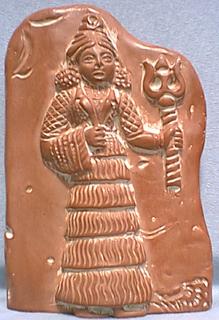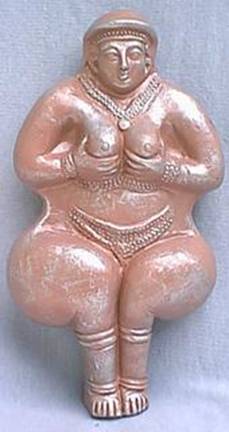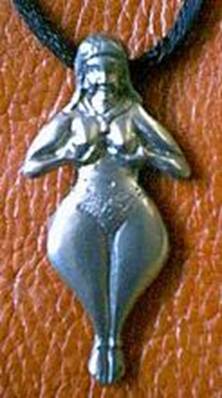THE White Moon Gallery Presents
|
Inanna Ancient Goddess ~ Modern Goddess |
|
|
by Artemisia |
![]()
![]()
![]()
![]()
![]()
![]()
![]()
![]()
![]()
![]()
![]()
![]()
![]()
![]()
![]()
Prologue
I discovered Inanna during my daily devotions in 365 Goddess by Patricia Telesco. I was attracted to the name, as it is so similar to my birth name. I felt drawn to research her further, and I found many references to her in The Goddess by Shahrukh husain. It was here that I discovered the Myth of Inanna’s descent and embraced it. I keenly understood the process of leaving behind vestiges of self until the naked soul is revealed. From this dark vulnerable place, a resting and rebirth takes place, and when the time is right, one emerges from the place of nothing to become more fully herself - closer to one’ s destiny. In Inanna, I had finally found the Goddess whose mythology embodied the Taoist Philosophies I live by.
In Taoism, one strives for moderation and balance, by letting go of unimportant ideas and material things. It is not a struggle to stay still and stagnant, but rather learning to dance in the flow of energies that run through your life. The Taoists explain that there is a female energy, Yin, which embodies the ability to create, to rest, and be empty - a place where all potential is possible. There is also the equally important masculine energy, Yang, which is action, generation, and fulfillment. In every aspect of life, these energies flow from one to the other in a never-ending cycle. The flow of energy is called the Tao, and once one learns to dance to the music of the Tao, through being emptied and filled with energy, one is always connected to the Divine.
![]()
![]()
![]()
![]()
![]()
![]()
![]()
![]()
![]()
![]()
![]()
![]()
![]()
![]()
![]()
Inanna’s Descent
Elinor Gadon, in The Once and Future Goddess, describes the evolving Mythology of Inanna, ancient Sumerian Goddess, in such a way to evoke the feeling that she has just told a story of a young maiden making the rite of passage into womanhood and her power. Not only has she gone through a rite of passage to claim her ruler-ship as Goddess, Inanna, the heroine of the story, is astute enough to understand the politics of the time in Sumer that she positions herself in such a way as to appease the new rulers, but yet keep the knowledge and tradition of the Goddess alive for centuries.
At the beginning of the story is the creation of the world which Gadon explains is symbolized by the huluppu tree which connects the underworld, the earth, and the heavens. At the time of the biblical flood, Inanna plants the tree in her personal garden so that she can turn it into her throne and marriage bed, as her rule and her sacred marriage are symbols of her power. This act of bringing the tree to her garden, and then making symbols of her power out of it, represent the taming of nature and bringing the Goddess out of nature into civilization - a political act. In fact, the next thing our heroine does is gain the ordering principles of civilization, called me from the God of Wisdom and bring them to her people in Sumer.

Now as Queen, Inanna must find a husband so that their sacred marriage will ensure fertility and fecundity for her people and their agricultural pursuits. She chooses Dumuzi, a Shepard from the invading peoples of the north as a political appeasement. They enjoy a luxurious honeymoon which has been chronicled in beautiful poetry, but when Dumuzi has gained his ruler-ship, according to Gadon, he “asks to be set free.”
Our Heroine, now that she is no longer enamored and has ensured the future of her land, just as a mother has ensured the future of her children, Inanna is free to develop her spirituality and find her true power. Inanna decides to learn about death and the underworld by traveling there. As she descends, Inanna is stripped of all her worldly possessions, all the things that define her life up until now. Inanna descends naked and vulnerable to the underworld, the dark void and womb of the earth, and hangs as a corpse on a hook, and to quote Gadon, “gains essential insight and experience into the full cycle of existence.” Inanna returns to her people, no longer just the Queen of Heaven and Earth, but as a Goddess who rules the cycles of life, death and rebirth - A Goddess who ruled over the people of Sumer and Babylon for over three thousand years (Harvey and Baring).
![]()
![]()
![]()
![]()
![]()
![]()
![]()
![]()
![]()
![]()
![]()
![]()
![]()
![]()
![]()
The multi-faceted Goddess
Inanna was known in Babylon and Sumer in different guises. She was known as Ishtar and Astarte. According to The Divine Feminine by Andrew Harvey and Anne Baring, the temples to Inanna and Ishtar were splendid and made of gold, and silver and lapis lazuli. She was worshipped as the Queen of Heaven symbolized by the crescent moon and the morning and evening stars. She was also Queen of the Earth, and trees such as the fig, apple or date always had a place in the temple courtyards. Cakes were made of her bounty and offered to her. Another important aspect of Inanna was her status as a virgin goddess, she belonged only to herself, and she was the Goddess of Love and Sexual Desire as this spiritual, divine, sexual energy was understood as what created bounty on the earth.

![]()
![]()
![]()
![]()
![]()
![]()
![]()
![]()
![]()
![]()
![]()
![]()
![]()
![]()
![]()
A Ritual: Return to the Womb
(written by me)
Sacred Space: a quiet, safe space with room to move around and a comfy space to sit or lie in the middle.
Tools: comforting candles or incense, silence or soothing music to cover background noises. Water to drink.
Start by standing and taking a few deep breaths. Stretch and relax any tense parts of your body.
Move gently around the room loosening up and drink some water. As you swallow the water, visualize it cleansing you and washing away all your negativities and troubles. When you are ready, begin your descent.
|
Starting at an outside corner of the room, begin to crawl on your hands and knees around the room in a circle. When you get back to the place you started, move in closer towards the center, and continue around the room spiraling into the center. You can chant “Inanna, Queen of Heaven and Earth, surround me with your love. Quiet my mind and soothe my heart. Inanna, Great Goddess, surround me with your love. Hold me close in your embrace. I am empty. My soul expands in your love.” |
|
When you reach the center, position yourself comfortably and breathe deeply. Consider the following meditation:
Great Goddess, I sit here surrounded by the dizzying aspects of my busy mind. They swirl and dance in my mind, distracting me from my purpose, to be One with you.
Bless me Inanna, wit the steadfastness to sit still and breathe, as you did on your descent. Let me find quiet and calm and open the door to the Womb in my mind where you reside.
Oh Inanna, let me retreat to your sacred space, leaving all things behind. Let me go to the Womb, the place where all things originate. Let me rest my weary soul and be emptied. Let me sit naked and vulnerable in the darkness and rest.
Great Goddess, when I am empty, rejuvenate me with your love and compassion. Fill me up with your Divine Light. Fill me up with myself - my deeper, quieter self who knows how to be one with you.
Inanna, when I am ready, slowly let me back into the world. Let me go forth into life with this new wisdom - Of Quiet and peace and steady mind.
Let me be as you, Inanna, coming forth from the darkness a new woman, stronger, wiser, knowing my power. Let my actions in the world be made, not by the whirlwinds of my mind, but by your will and purpose and Divine love.
After a time, when you are ready, stretch gently and take a few breaths. Follow the spiral you made in the opposite direction, out of the Womb. When you reach the beginning, stand up, stretch and gently go back to the world.
![]()
![]()
![]()
![]()
![]()
![]()
![]()
![]()
![]()
![]()
![]()
![]()
![]()
![]()
![]()
References
Gadon, Elinor W. (1989). The Once & Future Goddess: A Sweeping Visual Chronicle of the Sacred Female and Her Reemergence in the Cultural Mythology of Our Time. San Francisco: Harper Collins. 115-142.
Harvey, Andrew & Baring, Anne. (1996). The Divine Feminine: Exploring the Feminine Face of God throughout the World. Hong Kong: Godsfield Press. 54-67.
Husain, Shahrukh. (1997). The Goddess: Creation, Fertility, and abundance. Boston: Little, Brown and Company.
Telesco, Patricia. (1998). 365 Goddess: a daily guide to the magic and inspiration of the goddess. San Francisco: HarperCollins.
![]()
![]()
![]()
![]()
![]()
![]()
![]()
![]()
![]()
![]()
![]()
![]()
![]()
![]()
![]()
![]()
![]()
![]()
![]()
![]()
![]()
![]()
![]()
![]()
![]()
![]()
![]()
![]()
![]()
![]()

